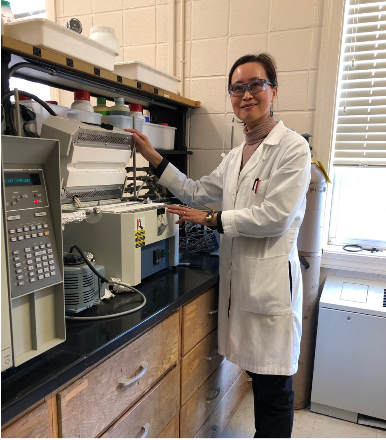Last updated on Apr 3, 2019
By Anand Venigalla
Features Editor
Dr. Cheng Zhang, assistant professor of chemistry, has been working on a project to convert carbon dioxide, a greenhouse gas, into value-added chemicals and fuels like ethylene and propylene.
“As the concentration of CO2 increases over the years, it’s really caused climate change, including global warming,” Zhang said. Zhang has been working with five students on this project: David
Zhang has a similar project using methane (CH4). “Methane is a big component of natural gas,” she said. “Natural gas is very cheap in the U.S. But methane is very harmful as a greenhouse gas. So actually it’s more harmful than CO2 and a [big] cause of global warming.”
Zhang wants to convert methane into methanol, a process she says will be significant to
Other projects include a paper on converting biomass and waste material into fuels in order to provide sustainable energy. This paper, “Essential Quality Attributes of Tangible Bio-oils from Catalytic Pyrolysis of Lignocellulosic Biomass,” is published in the Chemical Record Vol. 19
Zhang submitted an article on an industrial separation process she co-authored with Dr. Nicholas Ramer to the Journal of Chemical Thermodynamics on March 21. “We tried to use
Her process works through the use of a catalytic approach. “We develop catalysts in a lab and the catalysts can efficiently convert CO2 or methane into ethylene or propylene. The process is simple and also very unique in converting waste material into more valuable materials. We turn waste into treasure,” she said.
Zhang loved chemistry in high
Zhang did not immediately go into academia, and instead worked in the field. After graduate school, she worked as a senior chemist and project leader for more than 10 years with the R&D center of Headwaters in Lawrenceville, NJ, for Celanese in Houston, TX, and for Scientific Design Company in Little Ferry, NJ, before she joined LIU Post in fall 2015. She has also been an inventor /co-inventor on 35 patents in the USA, South Korea (KR), China (CN), the European Patent Office (EP), and the World Intellectual Property Organization (WO).
She was motivated to become a teacher due to the positive impact her parents and her teachers had on her. “Bonding is very important between the teachers and the students,” she said. “I always felt like I want to do something different.”

Her inspiration was partly due to her acquaintance with Dr. Stuart L. Soled, a distinguished research associate at ExxonMobil Research and Engineering Company and a fellow of National Academy of Engineering.
Soled told her, “
Zhang believes her experience in
Every semester, five to ten students join the project for credit. Zhang’s students are from diverse majors,
As part of her project in converting chemicals into sustainable energy, she explained the connection between carbon dioxide and the materials we use (clothes, computers, smartphones) and expressed the project to them in terms of solving a problem for real-world purposes. She also showed them how to create a catalyst. The simplicity of the process amazed them, she said.
This summer Zhang will mentor four students from the Brookhaven National Lab, two from the visiting faculty program (VFP) and two from the science undergraduate laboratory internship (SULI). The VFP program intends to increase the research competitiveness of faculty members and their students from historically underrepresented colleges, while SULI program
Students in the program will have access to the full range of facilities in the national



Be First to Comment